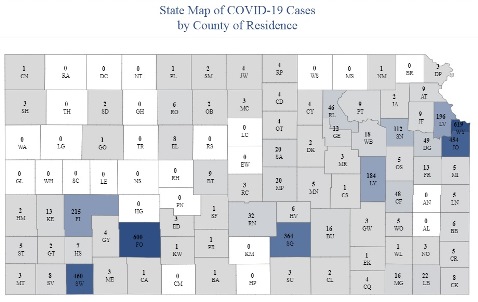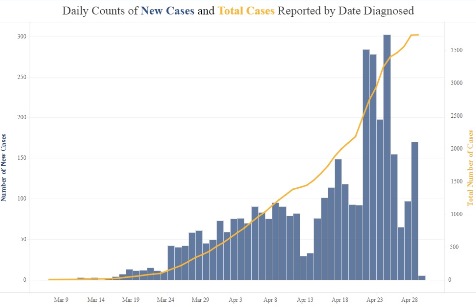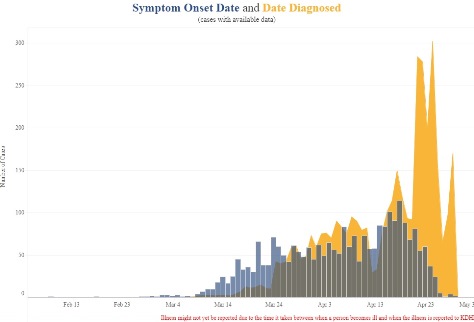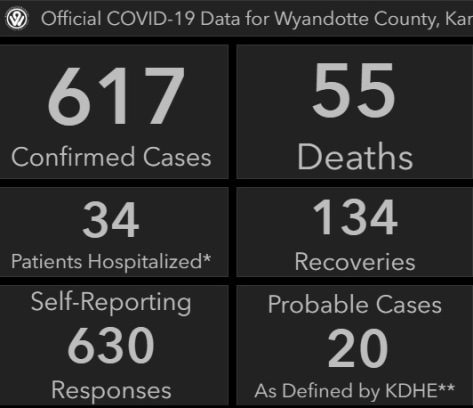



Gov. Laura Kelly today said she would sign a new state of emergency declaration on Thursday, extending the emergency to May 14.
The governor also said she plans to issue a new executive order on Thursday to extend the current executive orders.
COVID-19 cases increased by 247 statewide on Wednesday, according to the governor.
Gov. Kelly said a new executive order on Thursday will essentially lift the statewide stay-at-home order effective midnight May 4, and phase in a reopening of the Kansas economy.
The new order will set limits for mass gatherings and provide other guidance for counties, she said.
Gov. Kelly said that counties will be free to put in their own more restrictive guidelines if they wish.
She said that after May 14, the State Finance Council of the Legislature would be able to extend the emergency order 30 days to June 13. To remain in place beyond June 13, the entire Legislature would have to approve it by concurrent resolution, she said.
The governor said her new executive order on Thursday will not require any Kansas county to take additional actions. She said she has been assured by federal partners, including the Federal Emergency Management Agency, that the action will not affect any federal resources, including funding.
Gov. Kelly said the key to reopening the state will be expanded testing for COVID-19, and testing has lagged behind in Kansas.
She said Kansas has secured 500,000 USDA and FDA-approved testing kits from overseas. The first 5,000 have cleared customs and will be here shortly, she said. The state will receive 10,000 testing kits every week, she said.
In addition, federal partners are sending 25,000 testing kits this week and 25,000 more next week to assist in the state’s efforts, Gov. Kelly said.
The testing will inform the decision-making process based on data, as the state moes through recovery stages, Gov. Kelly said.
Also, Kansas is receiving FDA-approved equipment that will decontaminate N95 masks and make them safe for reuse by the workers who wore them, she said.
In addition, today the Kansas Department of Children and Families is extending the deadline for applying for help with winter heating bills through the Low-Income Emergency Assistance Program, she said.
New applications for assistance with heating bills will be accepted from May 1 to May 29, with details at www.covid.ks.gov and at http://www.dcf.ks.gov/services/ees/Pages/Energy/EnergyAssistance.aspx.
Dr. Lee Norman, Kansas secretary of health, said Centers for Disease Control staff are in Kansas working with the Kansas Department of Health and Environment in Topeka, and others are on the ground in southwest Kansas, where there have been outbreaks at meatpacking plants.
Meatpacking plants in Kansas are not being closed, but instead, procedures are being put in place to mitigate the spread of COVID-19.
Five CDC staff members will be here through 11 months, he said, to help with the epidemiology lab and contact tracing. The KDHE is in discussions to hire 25 full-time contact tracing and investigators, he said.
Dr. Norman said they now have the test kits and swabs that they need, with dentists coming through strong to manufacture some of the swabs.
He said the state will have equipment that will decontaminate the N95 masks this week, allowing the masks to be reused by the health care worker who wore them. There ewill be no mask-sharing, he added. Kansas health care facilities and first responders may use the equipment, which is baed in Topeka.
The state’s need for additional masks will continue, he added.
Dr. Norman said earlier forecasting about the number of cases and the need for beds was accurate, and in some cases, the state outperformed the estimates. He believes that COVID-19 has already peaked in the state.
Gov. Kelly said that leading up to the reopening plan, she has had a lot of conversations with other states to see what has worked, as well as with people throughout the state on the plan.
On Wednesday, Kansas reported 3,738 cases, an increase of 247 cases, in 78 counties, according to the KDHE statistics. There were 125 deaths, an increase of one death since Tuesday. There were 515 patients statewide who were hospitalized.
The Unified Government COVID-19 webpage reported 617 positive cases at 1:45 p.m. Wednesday, up 32 cases from Tuesday. There were 55 deaths, an increase of two since Tuesday, and 34 patients were reported hospitalized.
Meanwhile, Kansas City, Missouri, Mayor Quinton Lucas today announced a “soft” reopening of the economy there, phasing in the reopening in stages. The opening date is May 15, but some businesses will be allowed to reopen before that.
In Kansas, Wyandotte County had the highest total number of cases on Wednesday with 617. Ford County, the Dodge City area, increased by 56 cases on Wednesday and now has 600 cases, according to the KDHE report. Seward County, the Liberal area, reported an increase of 38 cases Wednesday.
Counties with 12 or more cases, according to the KDHE: Ford (Dodge City area), 600 cases; Seward (Liberal area), 460 cases; Johnson County, 454 cases; Sedgwick (Wichita area), 364 cases; Finney (Garden City area), 215 cases; Leavenworth County, 196 cases; Lyon County (Emporia area), 184 cases; Shawnee, 112 cases; Douglas (Lawrence area), 49 cases; Coffey (Burlington area), 48 cases; Riley County (Manhattan area), 46 cases; Reno County, 32; Labette County, 22; McPherson County, 20; Saline County, 20; Wabaunsee County, 18; Montgomery County, 16; Butler County, 16; Franklin County, 13; Kearny County, 13; and Geary County, 12.
KU doctors discuss procedures being ramped up at the hospital
There were 20 positive COVID-19 patients at the University of Kansas Health System on Wednesday, according to Dr. Dana Hawkinson, medical director of infection prevention and control at the KU Health System. Half of the patients were in the intensive care unit, he said. The numbers are declining, he said, and numbers were in the 20s and 30s for the past few weeks.
As society opens back up and restrictions are eased, Dr. Hawkinson said he hoped the numbers would stay down, though they expect a new baseline. They have been working hard this past week to put in the procedures necessary when more patients return to the hospital, he said.
Each community has its own COVID-19 curve, according to Dr. David Wild, vice president of performance improvement at KU Health System. There is not a single curve, he added. In general the curve for hospitalization appears to have been flattened, and most hospitals are not overwhelmed, which was one of the key points for the stay-at-home order. Here it appears the curve is flat, he said.
“A very large portion of our population has yet to be infected,” Dr. Wild said. More movement and more contact from individual to individual increases the likelihood of new cases and more people needing to be hospitalized, he said.
Dr. Terry Tsue, vice president of clinical services and physician in chief for the University of Kansas Cancer Center, said some cancer patients have twice the infection risk of the general population. It is not just because of their condition and their weakened immune systems, but also because they have so many visits and contacts outside the house, he said.
The health professionals’ goal has been to mitigate that risk by converting about one-third of the visits to telehealth, he said. The in-person visits have reduced dramatically without affecting the patients’ health care, he said.
Dr. Hawkinson said he doesn’t think he would get COVID-19 at the hospital because of all the safety precautions in place. Dr. Wild said patients with COVID-19 are separated from patients who don’t have it at the hospital.
Dr. Tsue said the KU Cancer Center has been open and will continue to operate. The volume of patients is down less than 35 percent and treatments are down less than 11 percent, he said. They have added precautions to keep patients safe, he added. No cancer patients there have received the infection, and no health care workers in their area have received the infection from patients, he said.
After an initial dip, the KU Cancer Center now is seeing an increase of patients who understand that the cancer risk is much higher than the risk of getting COVID-19, he said. Cancer surgery is continuing, he added. Patients are being tested for COVID-19 before surgeries and at different steps of treatment.
Also, Dr. Tsue said screenings are now being ramped back up again at the Cancer Center.
Asked about students who would like to hang out with their friends, Dr. Hawkinson stressed the importance of physical distancing.
As restrictions are lessened, people need to remember personal responsibility, he said. When outside, they should maintain distance, not hug and not shake hands, he added. In a closed area, they should wear masks, he said.
Another question, from a resident in Johnson County, was when it would be safe to visit her mom, who lives in a rural county.
Dr. Wild said each area is on its own sort of curve, and while they may not know the answer to the question of when it would be safe, there are many steps they can take to make the visit safer. That includes physical distancing, washing hands and the appropriate use of masks, he said.
It’s important to do things to mitigate the risk as much as possible, Dr. Hawkinson said.
Dr. Steve Stites said he’s not sure that travel makes a difference when the disease is now everywhere. The real question may be whether you should visit your mom, he said. It becomes a question of what you can do to make things safe.
Another question concerned people who want to go back to large sporting events next fall.
Dr. Tsue said practicing social distancing is going to be part of the new normal for any person’s life, with or without cancer. When games reopen, they will probably look differently than they have in the past, he said. A mask and good hand hygiene is probably a prudent measure when in that environment, he added.
To see the governor’s news conference, visit https://www.facebook.com/GovLauraKelly/videos/239470833798464/
To view the KU doctors’ news conference, visit https://www.facebook.com/kuhospital/videos/680726879167541/?tn=%2Cd%2CP-R&eid=ARCFFpKIRI_RtU20qi9cbVslOAaYmMV9yyMtHDGz8CzdvENFEnwVJSXIG_IKNAnwWUuXp0PM6Dutswoh
The Kansas COVID-19 website is at https://covid.ks.gov/.
The Kansas COVID-19 resource page is at https://govstatus.egov.com/coronavirus
The UG’s COVID-19 webpage is at https://alpha.wycokck.org/Coronavirus-COVID-19-Information.
Information from the CDC is at https://www.cdc.gov/coronavirus/2019-nCoV/.
